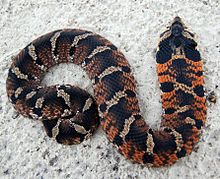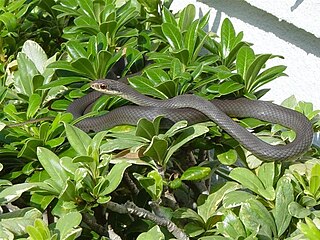Scientific Nomenclature: Crotalus adamanteus
The eastern diamondback rattlesnake, or Crotalus adamanteus, is a venomous snake in the pit viper, or viripidae, family. They are known to occupy a small region, spanning from Mississippi to Florida, and north along the coastline to South Carolina in coastal areas.
Their weight is significant, as they are the heaviest of North American poisonous snakes. Their length is surpassed by other pit vipers in North America.
Their markings are mottled brown, brownish-yellow, olive and grey hues with between twenty-four to thirty-five distinctive black diamond shapes dorsally. The diamonds are light colored in the center.. Towards the tail, these shapes flatten to appear more like bands or stripes. A single, dark stripe extends from the crown of their mouths to just behind the eye, and is bordered by a white or yellow stripe.
This species inhabits areas with marshes or pines and palmettos, or sometimes prairies. Occasionally they will dwell in old burrows of other animals, such as gopher tortoises and gophers in extremes of summer and winter.
Snake Bite
Sunday, May 15, 2016
Friday, May 6, 2016
Eastern Hog-Nosed Snake
Scientific Nomenclature: Heterodon platirhinos
The eastern hog-nosed snake, or Heterodon platirhinos, has slightly toxic saliva, yet they are rather reluctant to bite. On the rare occurrence someone has endured a bite, a mild edema is the worst known symptom. It is not considered to be harmful to humans, and has only been known to reach forty-two inches in length. It's small size also makes it non-threatening.
Habitat destruction has caused their populations to decline in number in many areas and extinct in others. Their range extends across the United States from the southern portion of New England to Florida, then, from South Dakota to the eastern half of Texas. They prefer to inhabit areas frequented by toads, such as moist pine woods.
The eastern hog-nosed snake, or Heterodon platirhinos, has slightly toxic saliva, yet they are rather reluctant to bite. On the rare occurrence someone has endured a bite, a mild edema is the worst known symptom. It is not considered to be harmful to humans, and has only been known to reach forty-two inches in length. It's small size also makes it non-threatening.
Habitat destruction has caused their populations to decline in number in many areas and extinct in others. Their range extends across the United States from the southern portion of New England to Florida, then, from South Dakota to the eastern half of Texas. They prefer to inhabit areas frequented by toads, such as moist pine woods.
To earn free bitcoins, while you learn, visit Snake Bite Faucet.
Tuesday, May 3, 2016
Northern Black Racer
Scientific Nomenclature: Coluber constrictor constrictor
The northern black racer, known officially as Coluber constrictor constrictor, may become slightly aggressive if provoked or startled. Although a bite from a fairly large snake may induce bleeding, the wound is typically superficial.
They inhabit a wide region from southern Maine and central Wisconsin that expands southward to North Carolina and northeastern Alabama. These snakes are not particular about their location, frequenting fields, backyards, swamps, and wooded areas. They are swift climbers. In order to provide adequate thermoregulation, they sometimes take shelter beneath manmade debris during shedding.
The northern black racer, known officially as Coluber constrictor constrictor, may become slightly aggressive if provoked or startled. Although a bite from a fairly large snake may induce bleeding, the wound is typically superficial.
They inhabit a wide region from southern Maine and central Wisconsin that expands southward to North Carolina and northeastern Alabama. These snakes are not particular about their location, frequenting fields, backyards, swamps, and wooded areas. They are swift climbers. In order to provide adequate thermoregulation, they sometimes take shelter beneath manmade debris during shedding.
Saturday, April 30, 2016
Speckled Kingsnake
Scientific Nomenclature: Lampropeltis getula holbrooki
The speckled kingsnake, or Lampropeltis getula holbrooki, sometimes measuring up to seventy-two inches, is predominantly black with a speck of yellow in each scale both dorsally and laterally. This pattern makes subterfuge difficult in some scenarios.
Although marvelous swimmers, speckled kingsnakes are mostly terrestrial beings and avid climbers. Good search locations are beneath old boards and piles of household rubbish from southeastern Alabama to eastern Texas, exceeding north to Iowa.
The speckled kingsnake, or Lampropeltis getula holbrooki, sometimes measuring up to seventy-two inches, is predominantly black with a speck of yellow in each scale both dorsally and laterally. This pattern makes subterfuge difficult in some scenarios.
Although marvelous swimmers, speckled kingsnakes are mostly terrestrial beings and avid climbers. Good search locations are beneath old boards and piles of household rubbish from southeastern Alabama to eastern Texas, exceeding north to Iowa.
Thursday, April 28, 2016
Red Rat Snake (Corn Snake)
Scientific nomenclature: Pantherophis guttatus
The corn snake, also known as a red rat snake, or pantherophis guttatus is a nonvenomous, North American species of snake that constricts its prey before consumption.
They are indigenous to the southeastern and central United States, and are moderate in length, easy to tame, and nurture, in addition to possessing remarkably striking patterns, making them popular as pets.
They benefit humans by controlling rodent populations, earning them their common nick name, corn snake, by association with corn crops and storage areas, frequented by rodents. These beautiful snakes are often falsely identified as poisonous snakes with a similar appearence, and, unfortunately, are slaughtered by mistake.
The corn snake, also known as a red rat snake, or pantherophis guttatus is a nonvenomous, North American species of snake that constricts its prey before consumption.
They are indigenous to the southeastern and central United States, and are moderate in length, easy to tame, and nurture, in addition to possessing remarkably striking patterns, making them popular as pets.
They benefit humans by controlling rodent populations, earning them their common nick name, corn snake, by association with corn crops and storage areas, frequented by rodents. These beautiful snakes are often falsely identified as poisonous snakes with a similar appearence, and, unfortunately, are slaughtered by mistake.
Subscribe to:
Comments (Atom)





